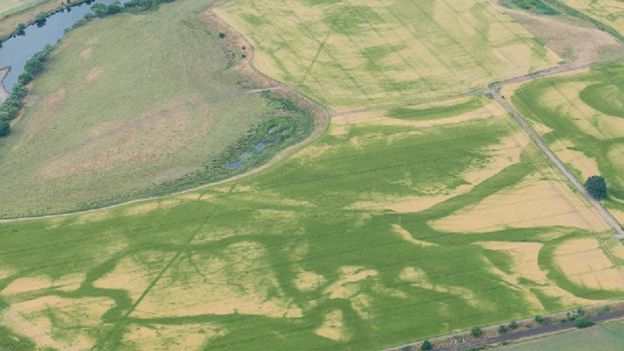Bubblecar said:
Pity there’s no longer a Time Team to dig it all up for us on telly.

The scorching weeks of the summer of 2018 left crops shrivelled and gardens scorched. It has also revealed the lines of scores of archaeological sites across the UK landscape, tracing millennia of human activity, from neolithic cursus monuments laid out more than 5,000 years ago to the outline of a long-demolished Tudor hall and its intended replacement.
Lost sites have been turning up all over Britain and Ireland, ploughed flat at ground level but showing up as parch marks from the air, in areas where grass and crops grow at different heights, or show in different colours, over buried foundations and ditches. A treasure trove of discoveries, including ancient field boundaries, lost villages, burial mounds and military structures, was revealed on Wednesday, recorded during the summer by aerial archaeologists flying over the landscape for Historic England.
Full Report
Thought I’d look up what was already known about this field. “Prehistoric monuments and settlement near Eynsham, Oxfordshire”. Other title “Scorched cropmarks reveal the buried remains of prehistoric funary monuments and settlement near Eynsham, Oxfordshire. The circle of pits have not been visible for years”. Um, fella, there is no “circle of pits”, do you mean “circular ditches”? Another source puts the date at “circa 4000 BC to 700 BC” (a bit of a wide range there) and says “This site was known about and is protected as a scheduled monument”.
A bit confusing as there are so many ancient relics nearby. https://www.british-history.ac.uk/vch/oxon/vol12/pp98-110
“Abundant evidence of human occupation from Palaeolithic times has been found in the parish, especially on the river gravels. In the south, in a heavily crop-marked area between the village and Foxley Farm, finds included a Bronze Age cemetery of the Beaker period, and many other Bronze Age features; a supposed henge south-east of the Stanton Harcourt road, however, is not now thought to be man-made, though the site, called Deadman’s Burial by the early 17th century, perhaps contained a barrow. Bronze Age burials and other features have been discovered north of the village, notably in the New Wintles Farm area, while the importance of the Thames crossing at that period is suggested by the discovery of shields at Swinford Bridge. The Foxley Farm area included an early Iron Age settlement, and another settlement of that period lay on the boundary with Hanborough north of City Farm. A large earthwork in Eynsham Hall park probably dates in part from the Iron Age; a smaller, oval earthwork close to the eastern boundary of the park has been ploughed out. A Romano-British settlement, with attached fields, has been identified north of Foxley Farm, and Romano-British artefacts have been found there, at New Wintles Farm, further south between Cuckoo and Mill Lanes, north of Newland Street near the primary school, and in the village itself, notably at the Gables and on and near the abbey site. An important Romano-British coin hoard, buried c. 330, was discovered in the fields in 1935, but the precise location was not recorded.”.
This one, perhaps? “A large earthwork in Eynsham Hall park probably dates in part from the Iron Age”.





